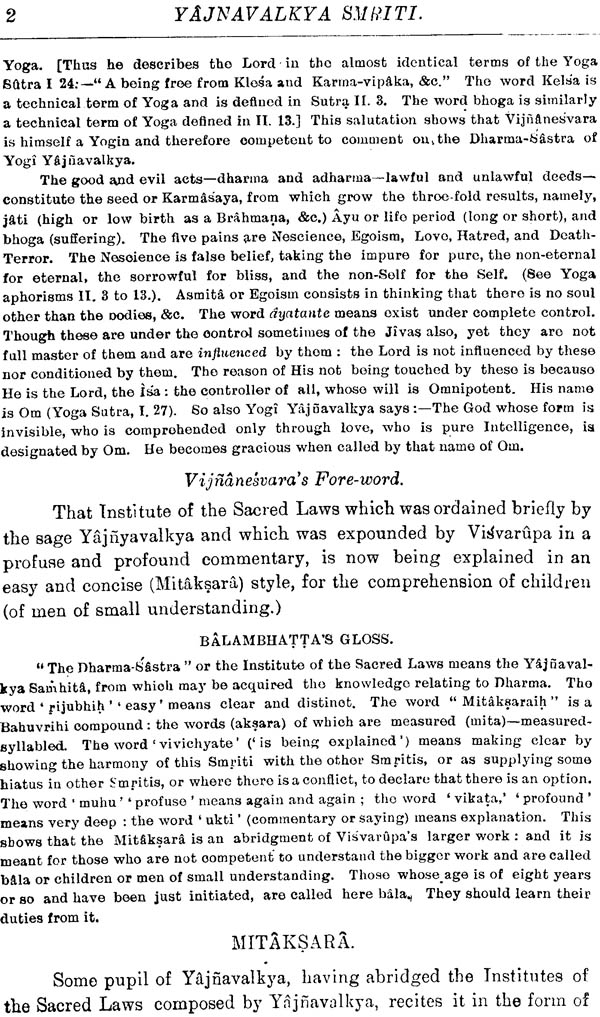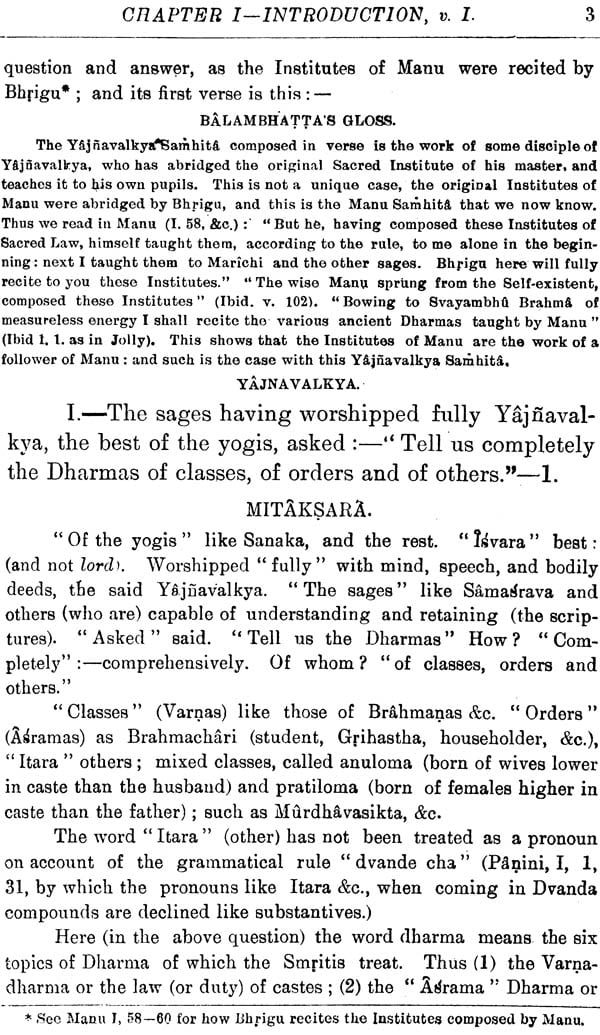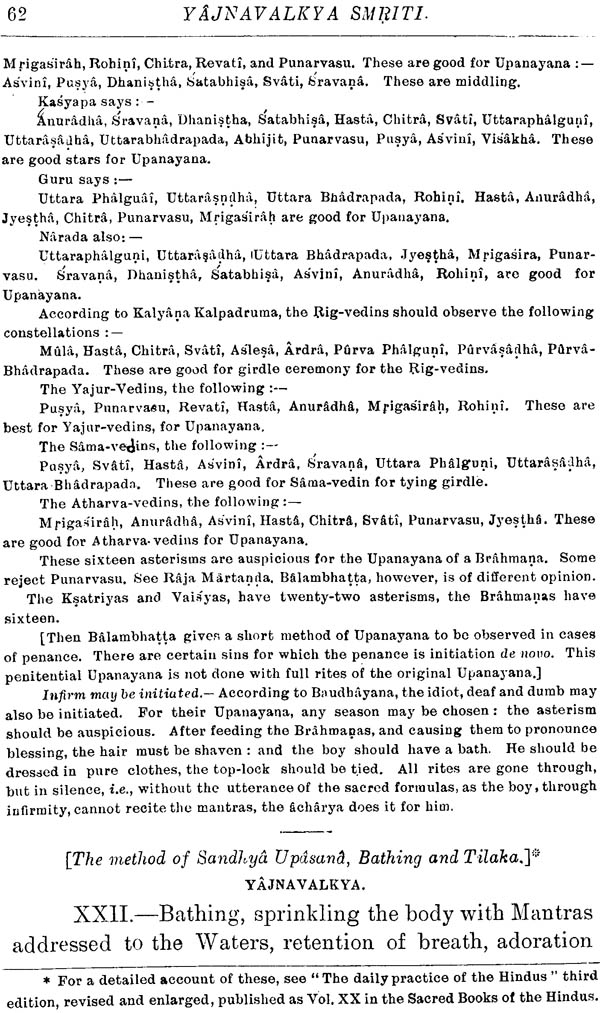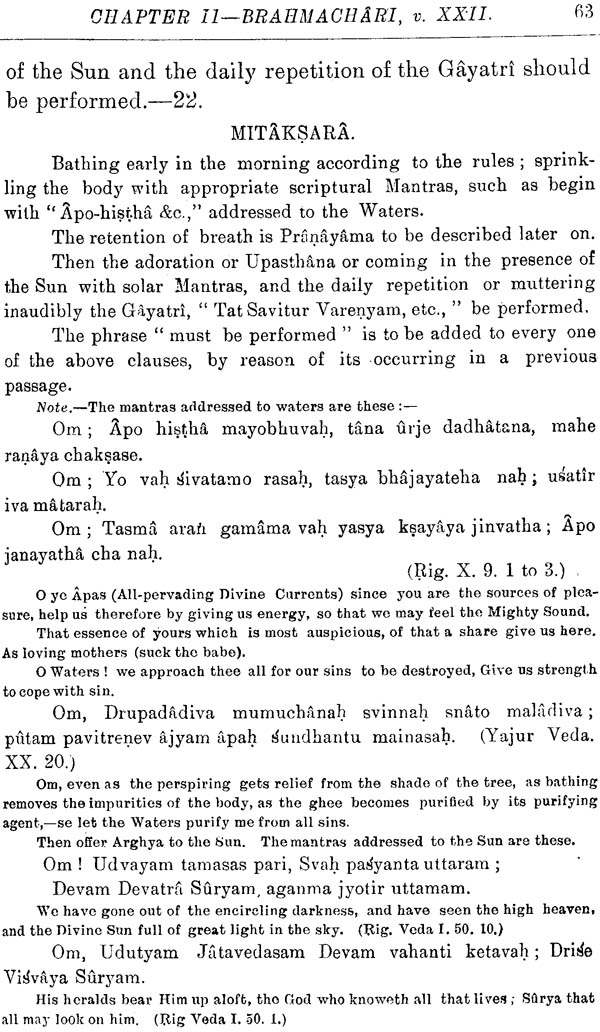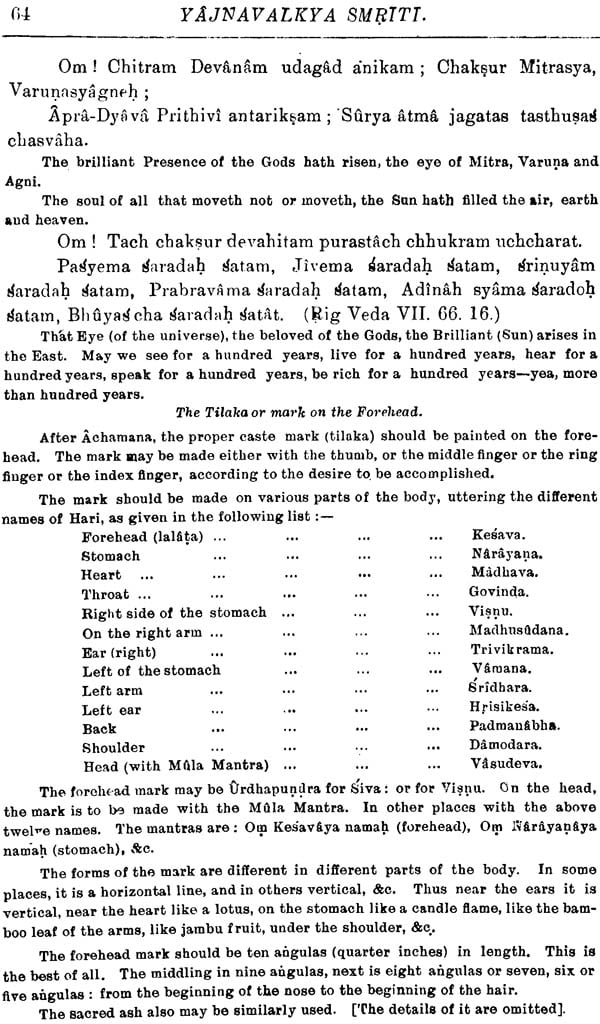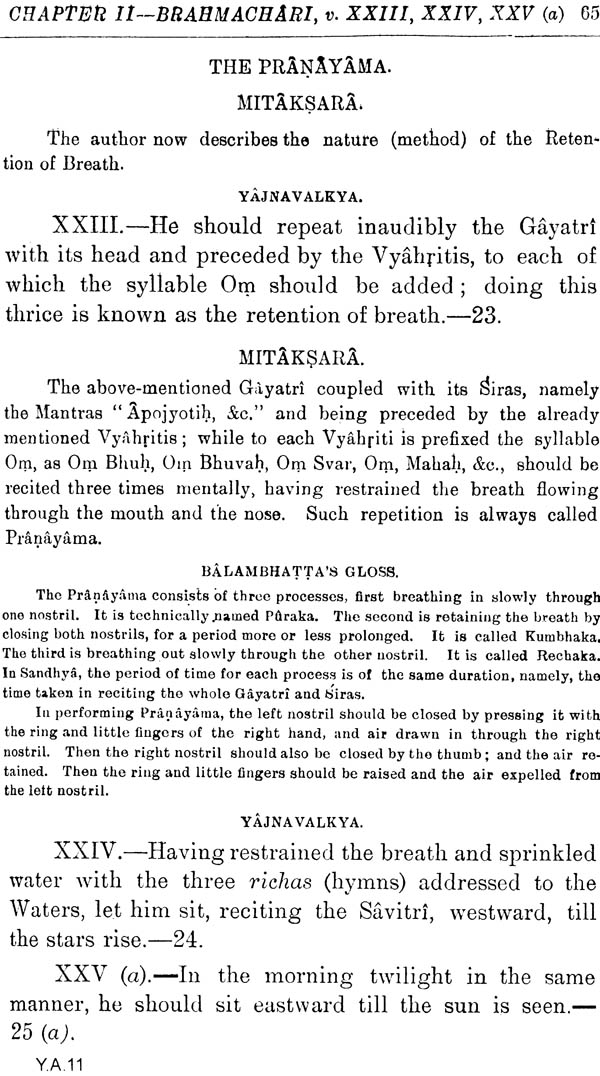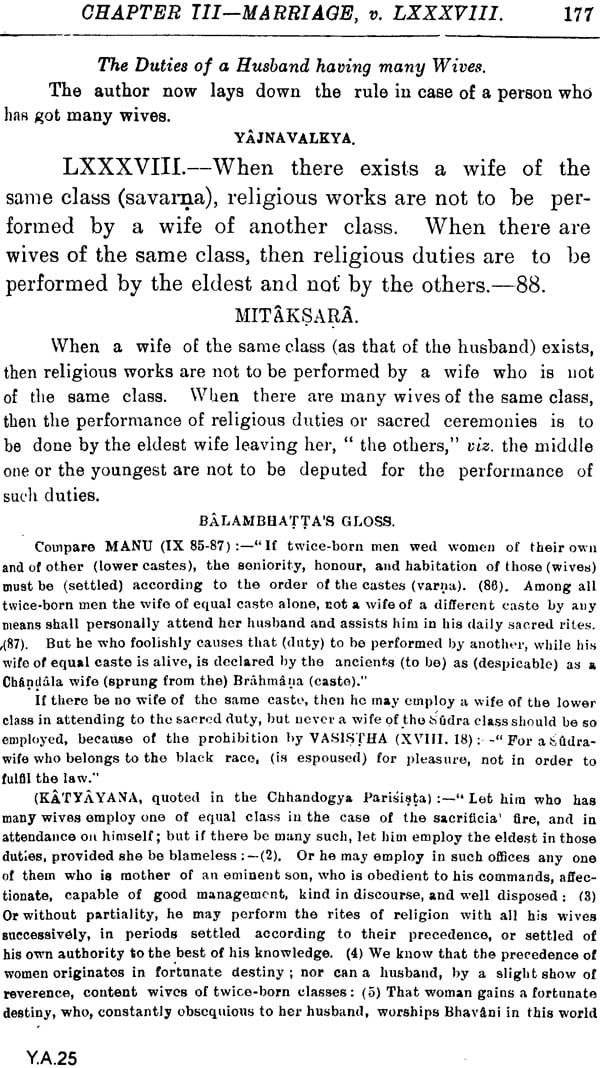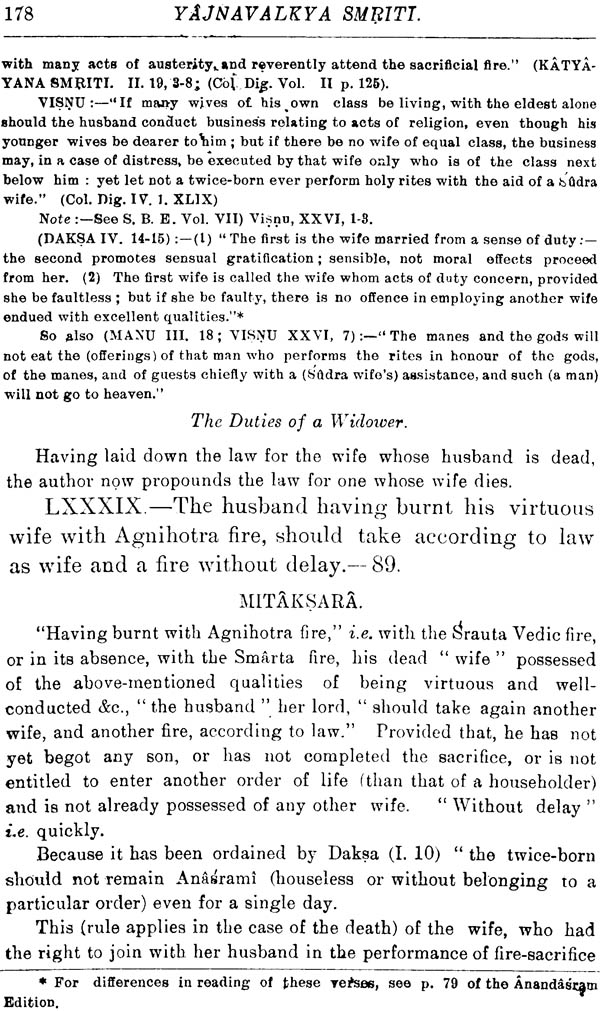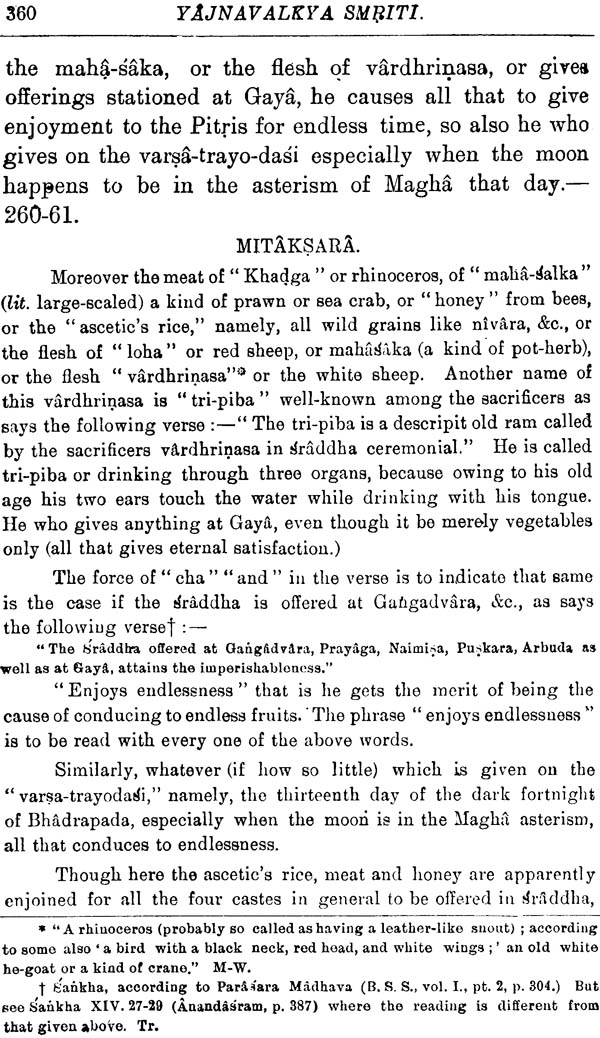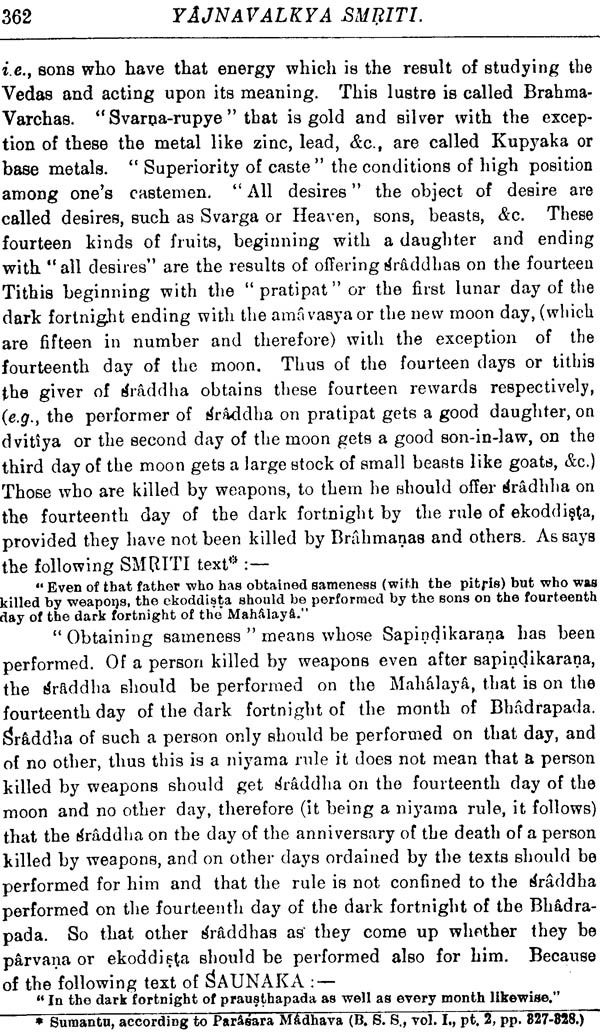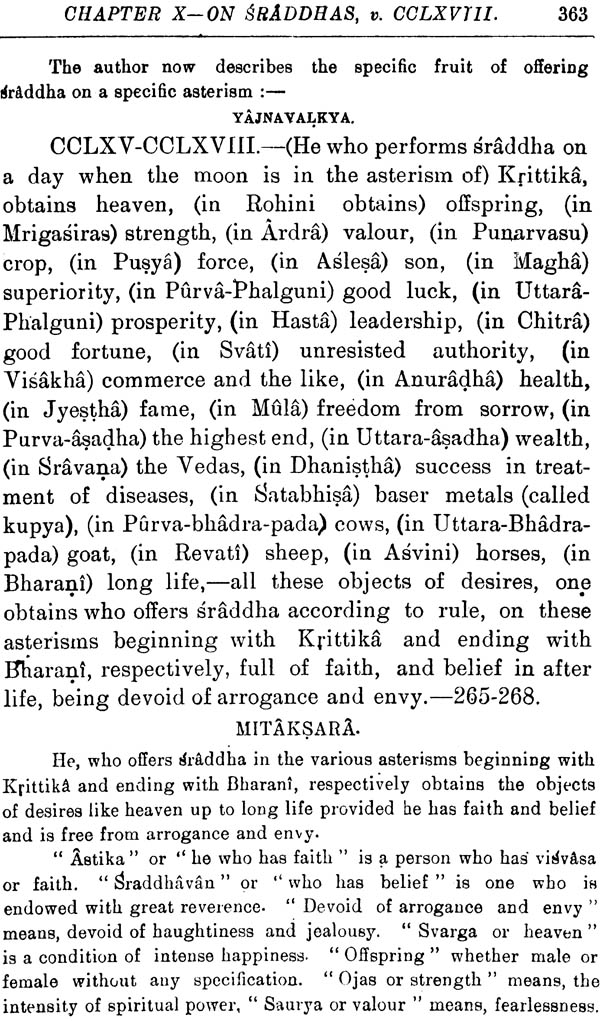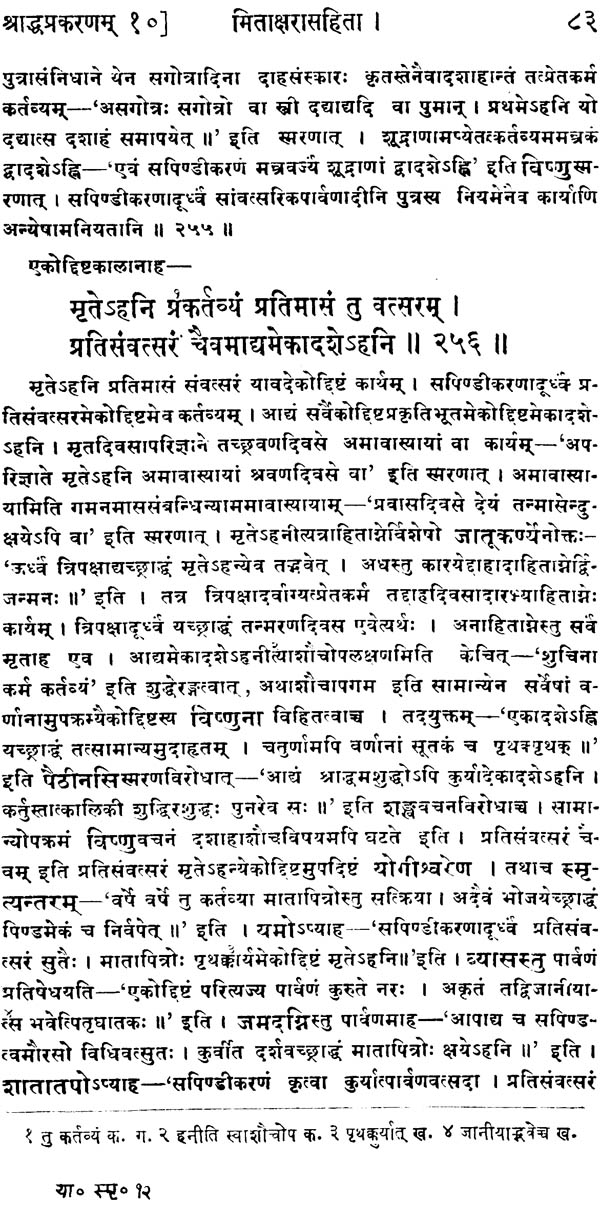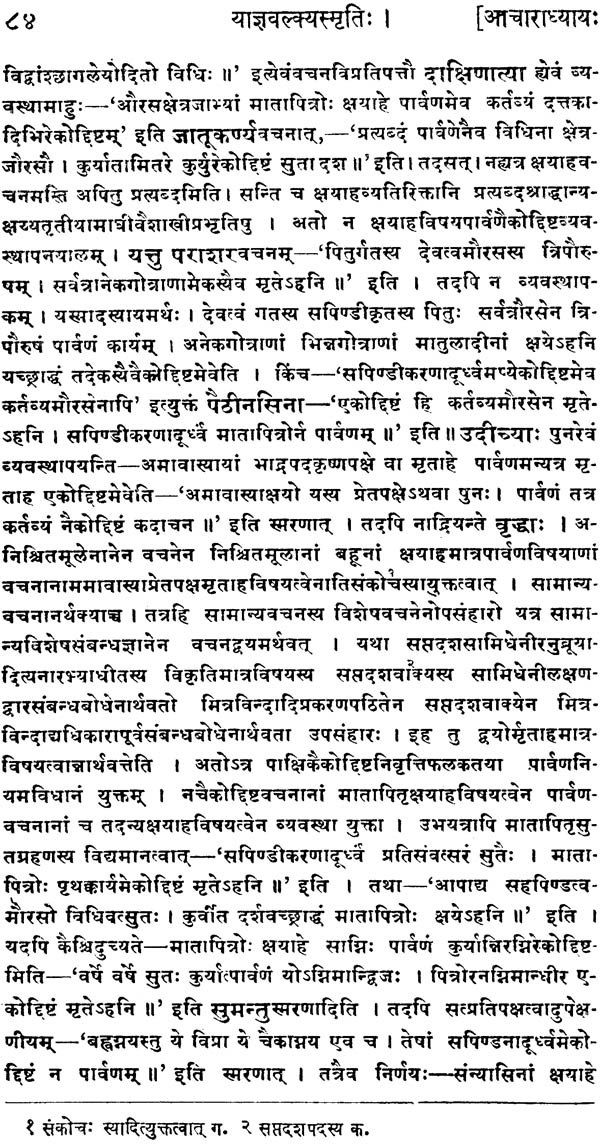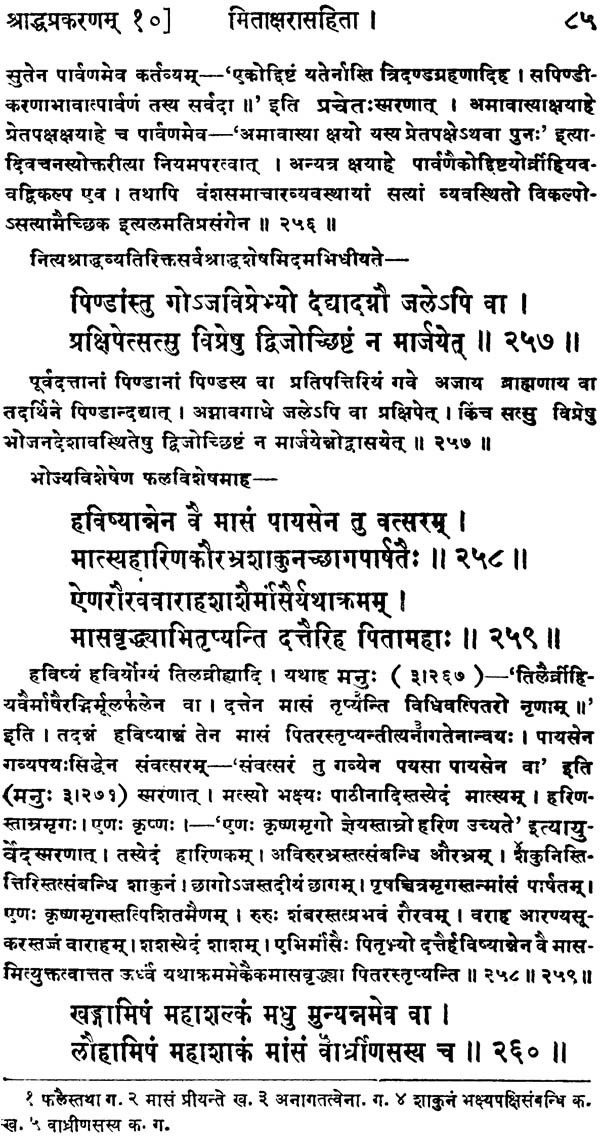
Yajnavalkya Smrti: Acaradhyaya with English Translation of Commentary Mitaksara
Book Specification
| Item Code: | NAD210 |
| Author: | Late Rai Bahadur Srisa Chandra Vidyarnava |
| Publisher: | Chowkhamba Sanskrit Series Office |
| Language: | (With the Translation of Two Sanskrit Commentaries) |
| Edition: | 2003 |
| ISBN: | 8170801176 |
| Pages: | 458 |
| Cover: | Hardcover |
| Other Details | 10.0 inch x 6.5 inch |
| Weight | 1 kg |
Book Description
Next to Manu’s Institutes of Sacred Law, the Smriti of Yajnavalkya is the important. It contains 1010 slokas or stanzas; and is divided into three Adhyayas; or books, namely Achara or ecclesiastical and moral code; Vyavahara or the civil law and Prayachitta (Penance) or the penal code. Each part or Adhyaya contains the following number of stanzas
The Achâra (368 stanzas.)
The Vyavahtra (307 stanzas.)
The Prâya.chitta (335 stanzas.)
The whole of. Achara is divided into 13 chapters thus
Chapter I Introduction 1—9 Stanzas.
Chapter II Brahmachri 10—50
Chapter III Marriage 51—89
Chapter IV Varna-Jtti 90—96
Chapter V Grihastha 97—128
Chapter VI Snttaka-Dharma 129—166
Chapter vII: Food 167—181
Chapter viiI’ Purification of things 182—197
Chapter IX Dana 198—216
Chapter X Sraddha 217—279
Chapter ‘Xl Worship of Ganesha 271—294
Chapter XII Graha-anti 295—808
Chapter XIII Raja –Dharma 309—308
There are several well-known commentaries on Yajnavalkya’s Institutes ; such by Apararka. Visvaropa, VijineSvara, Mantra Misra and SuIapâi. But the commentary of Vijinanevara has superseded thee others and under the name of the are it is accepted as authoritative by the Hindus of most of the provinces Ella. Tim full name of the commentary of Vijinânevara is Riju-mitakara or the y and Concise But the name Mitâkarâ has become so well-known that it is late now to revert to the name given to ft by the commentator himself. Even Sanskrit authors the book is quoted, for the sake of brevity, as the Mitaksara.
The gloss of Balambhatta is a comparatively recent one. It is rather eneypedic in its scope. The book professes to have been composed by a learned , but Babu Govinda DEisa of Bdnares, the learned editor of the Edition Princes of lymphatic states that the real author of it was the bnshand of this lady. The Taidyaufttha Paiyagnnda lived in the eighteenth century, and as he lived in there is every reason to believe in the troth of this Benares tradition.
The whole of Yâjdavalkya’s lostitotes was translated by Mr. Mandlik into in 1880 A. P. baying, of course, the commentary and the gloss. I am much indebated to that translation in my rendering of the verses of Yajdavalkya.
Iii translating the commentary of Vijinenevara (i.e. the Mitakasara) I have to be as literal as was consistent with readable presentation of the original. the gloss of Btlambhatta however, the translation is mostly free; and in several these it is even an abridgment of the gloss. Moreover I have not translated the whole of it, but only such extracts as I thought would be interesting to general readers. The gloss of Brahambhatta is a storehouse of information, proceeding on the same lines as the Viramitrodaya. I have given also comparative extracts from the Grihya-tras to show the nature of those’ treatises; and to give concrete notions of these books to ordinary readers so that they might not remain as mere names. The translations of these books in May Muller’s series, of the Sacred Books of the East have, of course, been of great help to me. I have given the exact translations of these as they appeared in that series, except in one ease where the phrase “the wife addicted to her husband,” has been changed to “the wife devoted to her husband.”
The first chapter contain, the sources of the Hindu Law. Among the sources of the Hindu Law, Yjflava1kya enumerates the well-known fourteen avidities o sciences (according to some eighteen, namely, the four Vedas—the Rich, the You, the Stoma and the Arthurian—the six Vestiges or Appendages to the Vedas— the Phonetics, Liturgy, Grammar, the Lexicon, Astronomy and the Prosody—and Login, the Exegetics, the Puritans and the ) Jharma-Sstras or the Institutes of the Sacred Law. AU these fourteen subjects are not only sources of Vides or knowledge but of law also. Ytjniavalkya then enumerates the various Institutes of the Sacred Law, such as Manu, Atria, &e. According to him the authoritative Smites are 20 in number as named by him; but according to the commentators this number is raised to S or more by enumerating others not mentioned by Ytjiniavalkya. Considering the question of the sources of law, from a still different point of view, we arrive at a four-fold division, namely, 1. the Vedas, 2. the Stniti or Dharma-sastra, 3. the Custom (sadâchra), 4. Voluntary.
According to this division, the custom holds a third place ; and the general rele of Hindu Law as to the relative authority of these four is that the Vedas or the Revelations are the supreme authority, next to them are the Smirtis or the Institutes of the Sacred Law, and third, the customary Law. The rule of interpretation in ease of conflict among these is that the Revelation (the Vedas) would prevail over Tradition (the SimCity) and the Tradition over the Custom. There cannot be any valid Custom opposed to the Vedas or the Smirtis.
The modern idea, that prevails in our Courts, is that the customary law is the highest, and the written law (the Vedas and the Smirtis) of secondary importance. Whether Yet flavalkya or Vi) fftnedvara would have supported such a view I leave the readers to judge.
The Second Chapter is called the rahmaehtz’i Parka. Ytjflavalkya mentions the well-known ten sacraments of the Hindus, but gives no details of the ceremonies. His commentator Vijfiânedvara also does not enter, in his Mitlrsarfi, into any detailed exposition of these. But Bumboat supplies the omission. All these ceremonies are described in copious detail in this gloss. They are certainly of great use to every pious Hindu. All good Hindus, who want to regulate their conduit properly, and wish to see that these ceremonies should be properly performed by their priests, should at least know the general outline of the rituals. The want at this knowledge of the rituals, by the Hindu laity has reacted on their priests also. The priests have become in many eases ignorant and the ceremonies, the proper performance of which would take hour, are finished perfunctorily within half that time. I have given an almost full description of one ceremony namely the Sati Ply that would show what other c-remains are like. This Saatchi Put is one of the elementary ceremonies, yet even this contains more than a score of Veda Mantras. Even if our priests know how to recite these mantras, ten to one, they do not know their meaning. Unless the yajamtus (the sacrifices) know something of these ceremonies, there is no hope that the priests will be better than what they are now. At the same time pajamas must not expect to get a better class d priests unless they raise the remuneration of these to respectable figures. This second chapter (BIambhatta) contains also the famous law of adoption by baudhâyana. I have given the full Sanskrit text, its word meaning and translation made by Dr. Buhler. The word meaning, I hope, would be found useful to those legal practitioners whose knowledge of Sanskrit is elementary. As regards the two sacraments—the Puilsavana (the ceremony to secure the birth of a male child), and the Simantonnayana (the parting of the hair of the pregnant wife—from which date all marital relation should Cease), I have given copious excrete its from the Ginny Smarts relating to these ceremonies as prevalent in ancient zest. The rules of Brahmanchrin in ancient time aimed at making man of a student. Only those are fit to be members of a noble and highly organized community who au in their school days the lessons of plain living, and discipline. The students ancient times had to live in the houses of their gurus which were generally far away from the busy haunts of men : generally in forests, while learning all the sciences that ancient India could impart—and they were not few—they were scruple guarded from participation in all active duties of life. They were, in the first alee, unmarried and not like the majority of our I-Ugh school and College students, ‘-h babies at home. They were taught to respect their teachers and rulers, and take teachers and rulers in their turn loved and protected them. They respected the king and the king respected them. They had absolutely nothing to do with iritic. The sons of kings and ruling chiefs were undoubtedly taught all the laws of political economy (Artha-âstra) and statecraft (Râja-Niti) but even they were it allowed to mix in any political agitation of the time, if there were any such kings in those days. Nor can it be imagined that a student of those Vedic schools, read in his garment of antelope skin and bearing a water pot in hand was ever found rare{king a deadly weapon against any human being. It was not the duty of the sent to carry on the agitation for the redressing of the wrongs, real or imagine. Awry. Done to him or his Country. If a Brahmachârin broke his vow and transgressed e rule of his arnica, he was looked down with contempt and not in any way cru raged in his wrong path. Such was the student and such the Guru. It is asking short of a sad decadence of religion, in this land of religion, that the noble .lesion the Brahmacharya 4rama should have entirely disappeared. .
The third chapter on Marriage deserves careful study of Ethnologists, for no tent of Evolution of Marriage can word to negated it. Top make this chapter as ‘relate as possible, I have added copious extracts from the gloss of Bâlambhatta. .
The fourth chapter on Castes with Notes from Bâlambhata will be found useful he who are interested in the question of Castes in India. There are several on this subject written by Sir George Campbell, Read. Mr. Shirring of Beanery,
our of Bombay, Mr. Thurston of Madras, Sir H. Risley, Dr. Jogendra a of Bengal and a few others, hut curiously enough, none of them on salted Yâjfiavalkya with its several commentators and the gloss Yet those authors would have greatly benefited by a perusal of r of the present work. .
Not considered necessary to add notes from the gloss of Bâlambhatta to I. ionic, 7th, 8th and 9th chapters.
Bye tenth chapter on larded is an important one, not only to the antiquarian, practicing lawyers in India. At present there is no treatise in English, co-elusively devoted to this subject. Hence, I have added such notes as I considered necessary to elucidate the matter.
The eleventh and twelfth chapters are not of much importance to the practicing lawyer but will interest students of Indian religious cults.
The last chapter is difficult to understand without studying the Artha-iâstra. This has been now made possible by the publication of Kantilla Artha-stra with its English translation; Prof. Benny Kumar Sparker’s urbanity and Positive Back ground of Hindu Sociology and Law’s Hindu Polity.
The importance of the study of Hindu Law in all its different branches will be evident from what Sir Henry Sumner Maine says that India “may yet give us a new science not less valuable than the science of language and folk lore. I hesitate to call it comparative jurisprudence, because if it ever exists, its area will be so much wider than the field of law. For India not only contains (or to speak more accurately, did contain) an Aryan language older than any other descendant of the common mother tongue and a variety of names of natural objects less perfectly crystallized than elsewhere into fabulous personages, but it includes a whole world of Aryan institutions, Aryan customs, Aryan laws, Aryan ideas in a far earlier stage of growth and development than any which survive beyond its border.”
What Maine hesitated to call comparative jurisprudence cannot be brought into existence unless the legal lore of ancient India is properly studied. The fact cannot be denied that the contents of the law books of the Hindus are not so well- known to Indian legs) practitioners unacquainted with Sanskrit as they deserve to be. Lawyers in India chiefly confine their attention to the chapters on Inheritance, Adoption and Partition of Hindu Law. But it is difficult to understand the theory and practice of that Law without studying all the topics dealt with in the Achra and Priiyaohitta Madhya’s of Yaniavalkya Smriti. Pânini office has published English translation of two books of Yaniayalkya with the commentary of Vijdanevara and thus made them accessible to English-educated people unacquainted with Sanskrit.
A knowledge of Sanskrit Grammar and the six schools of Hindu Philosophy in general and of the Flora Mittens in particular is necessary to understand the original Sanskrit text of Hindu Law. Plain office has tried to supply this want by the publication of the Attdhyâyi and the Siddhdnta Kamahi as well as of the is schools of Philosophy in the Series of the Sacred Books of the Hindus.
In the preparation of this translation I was greatly assisted by the late Pundit Saran Prasad Mira of Allahabad. He was well read in many branches of Sanskrit literature—but his forte was Hindu Law and Philosophy.
The Bengali and Hindi translations of this work have been also of some help to me.
It has not been thought advisable to insert Sanskrit text in the present publication. There are several printed editions of the original Sanskrit text, hut the best and the cheapest is the one published by the Nitrify Sager Press of Bombay, the price of which is two rupees only.
The sacred literature of the Hindus is known as (i) Sruti and (ii)Smriti. Sruti literally mens whiat is heard. The Vedas, Aranyakas and Upanisads are included in this class. Itihasas, etc,. belong to this category. Smritis, therefore, are not like the Vedas, considered to be eternal and unchangeable. Every Yuga or cycle had its own Smriti.
It is not necessary to enter into the question as to the origin of smirits. Those who take interest in the subject are recommended to peruse the works noted below. Suffice it to say that the smritis were brought into existence as printed in the collection of 27 Smritis published by the anandasram of Puna The opening verses of that Smirit , bring out this fact very clearly.
Devalue was a port on the Indus in Sindhi regarding the invasion of which by the Arabs, Mr. Stanley Lane—Poole writes:--
“The story of Mohammad Kasim’s adventures is one of the romances of history. He was but seventeen, and he was venturing into a land scarcely touched as yet by.
Saracen spears, a laud in habit do by warlike races, possessed of an ancient and deeply rooted civilization, there to found a government which, however successful, would be the loneliest in the whole vast v. Mohammedan Empire, a province cut off by sea, by mountains, by desert, from all peoples of kindred race and faith. Youth and high spirit, however, forbade alike fear and foreboding. The young general had at least six thousand pieced horsemen to his back, chosen from the caliph’s veterans, with an equal number of camera, and was supplied with a baggage-train of three thousand Bactrian camels. Marching through Moran, along the Persian coast, he was joined by the provincial governor with more troops; and five stone- slings for siege-work were sent by sea to meet him at Album, the great medieval port of the Indus valley, the for runner of Karachi.
“There in the spring of 712 Mohammad Kasim set up his catapults and dug his trench. A description of this siege has come down to us from an early historian (al-Kalahari, writing about 840), from which it appears that the Arab spearmen were drawn up along the trench, each separate company under its own banner, and that five hundred men were stationed to work the heavy catapult named ‘the Bride.’ A great red flag flaunted on the top of a tall temple, and the order came from Hajji, with who the general was in constant communication, to ‘fix the stone-sling and shorten its foot and aim at the flagstaff’ so the gunners lowered the trajectory and brought down the poise with a shrewd shot. The fall of the sacred flag dismayed the garrison; a sortie was repulsed with loss; the Muslims brought ladders and scaled the walls, and the place was carried by assault. The governor fled, the Brachyurans wore butchered, and after three days of carnage a Mohammedan quarter was laid out, a mosque built, and a garrison of four thousand men detached to hold the city.” Medieval India under Mohammedan rule, by Stanley Lane—Poole (story of the Nations series).
Some of the inhabitants of Singh either voluntarily embraced the religion of the Invaders or were forcibly converted to it. It was necessary to bring back the lost men to the fold of Hinduism. The Devala Smriti shows not only the tolerant nature but statesmanlike grasp of its author.
With the exception of Mann, Yajiniavalkya and a few others, the Smritis, as a rule, do not treat of Vyavahtra or what may be called Legal Procedure or Positive Law. This formed the subject matter of Arthaâstra, which treated of Statecraft, International, Municipal and Positive Laws. Sovereigns administered Civil and Criminal Laws according to ArthaIástra.
It is a remarkable fact that the Smritis nowhere mention the existence of prisons or punishment by incarceration. It may be that in Hindu India as there ‘was no Poor Law, so there were no jails which not only degrade their inmates but also manufacture criminals. But in. the Arthastra of KauiIya, there is distinct mention of prisons and of their superintendents.
It is probable that In course of time, Arthaiâstra was ignored, and Smitie came into more prominence than ever. According to Hindu law-givern, if there is any conflict between ruti and Smriti, the former is to prevail. On this analogy, the later Sniiiti writers declared that the statements of Bmlitis were to be preferred to those of Arthatstra. But on this point the latter says
“But whenever sacred law (Sastra) is in conflict with rational law (Dharmany yaw=King’s law), then reason shall be held authoritative; for there the original text (on which the sacred law has been based) is not available.” (P. 12, Outlay’s Earthstar, English Translation.)
Biihler has also pointed out how Kamandiki in his Niti-sara has rejected the opinion of Manava. He writes (pp. xxxvi, xxxvii and xxxxviii of Introduction; of Laws of Manu, S.B.E., Vol. xxv):-
“More important than the passages from the last work is the evidence which the Kamandakiya Nitisara furnishes, where twice opinions of the Manavah and once an opinion of Manu are quoted, but rejected in favor of the views of the author’s teacher, chanakya Kautilya. Nor is it usual to contrast, as Kamandaki does, the rule taught by Manu with these of other teachers and after words to reject them. If a Hindu writer on Law finds it necessary to set aside an opinion of Manu, he either passes by it in silence or he interprets the passage where it occurs in accordance with the principles of some other smrits with which he himself agrees.”
It appears that origionally smirits were codes of Ecclesiastical Law, but on the revival of Hindusim, the Brahmanas were not slow in incorporating Positive Law in smirits, ignoring altogether the existence and importance of the Arthasastra. It is misfortune of India that in the early days of the British Rule, Arthasastra was not discovered for this would have prevented the codification of Personal Law of the Hindus on the present lines.
Arthasastra is also one of the sources of Hindu Law. Yajnavalkya I. 3. mentions 14 sources of Law. Nyaya” in that verse as “Dharma Nyaya”= King’s Law or Arthasiastra.
There can be little doublt that Yajnavalkya was posterior to Kautilya, author of the Arthasastra, The latter disapproves of compounds of more than three words. For, He syas:--
“Combination of words consisting of not more than three words and not less than one word shall be so formed as to harmonise with the meaning of immediately following words.”
(p. 82 of the translation of Kautilya’s Arthasastra, by R, Shamasastry.)
But in Yajnavalkya smriti and later Sanskrit, compound words greatly prevail. Thus it is evident that it is now engaging the attention of some of the most distinguished graduates of our Universities. The publication of the Sanskrit text as well as the English translation of Kautilya’s Arthasastra by Mr. nsamasastry of Mysore, ground of Hindu Socilogy, as well as the wreitings of Mharaj Kumar Narendra nath Law, M. A. B. L. P. R. S. show the zeal with which this brach of Sanskrit literature is being studied in this country.
The influence of Arthasastra on Smritis should form the subject of research by some competent Hindu lawyers.
The number 18 is a mysterious number with the Hindus. Like 18 aithoriative Puranas, the number of aithoritiative smirits is also said to be 18. But as the Puranas, including Upapuransa, number more than 18, so do the somirtis also. Many of the smirits have been lost or found in fragments or some of their texts in commentaries or digests only.
| | ||
| Chapter I | Introduction | 1 |
| Vijiânevara’s salutation | 1 | |
| Vijlânevara’s foreword | 2 | |
| Visvarupa’s Commentary referred to | 2 | |
| The question of the sages | 3 | |
| The six kinds of Pharma | 3 | |
| The territorial jurisdiction | 5 | |
| The fourteen sources of Dharma | 5 | |
| The eighteen Purânas | 6 | |
| The two Bhagavat Puras | 6 | |
| The Upapurâias | ||
| The authority of the Per ias | 8 | |
| The list of Smitis | 9 | |
| The efficient cause of Dharrna | 10 | |
| The Janapaka cause of Dharrna | 10 | |
| The Four-fold evidence of Dharma (verse 7) | 12 | |
| The Conflict of Laws | 13 | |
| The self-realisation, the highest Dharma (verse 8) | 15 | |
| The Legal assembly or Parisad | 15 | |
| Chapter II | The Sacraments and Studentship | 16 |
| The Four Castes (verse 10) | 18 | |
| The T’wiee-born (verse 10) | 18 | |
| The Sacraments :— | 18 | |
| (a) | Garbhfldhâua | 19 |
| (b) | PtnisaVaua | 20 |
| (c) | Simantonnayana | 20 |
| (d) | Jâta Karma | 20 |
| (e) | Nflma Karma | 20 |
| (f) | Nikramau | 20 |
| (g) | Annapraanz | 20 |
| (h) | Chudâkarana | 20 |
| Paiziess delivery ceremony | 22 | |
| Rules for pregnant women | 22 | |
| Rules for their husbands | 23 | |
| Birh rite | 23 | |
| Adoption | 24 | |
| Sasthi Puja | 28 | |
| Naming Ceremony | 31 | |
| The Secret Name | 37 | |
| The Naksatras and Names Table | 38 | |
| The Niskraman | 39 | |
| Iupavesana | 39 | |
| Annaprasana | 40 | |
| Boring of the Bar | 40 | |
| The birthday anniversary | 40 | |
| Chudakarana or the tonsure | 42 | |
| The sikha | 43 | |
| Apastamba on pumsavana simantyonnayana | 44 | |
| The first learning of the Alphabet | 46 | |
| The utility of the Sacraments | 53 | |
| The time of Upanayana | 54 | |
| The duties of Gurus | 55 | |
| The study of the OtyatrI | 56 | |
| The rules of Personal purification | 57 | |
| A chamana and its method | 62 | |
| Auspicious stars for initiation | 63 | |
| Sandhya | 64 | |
| Marjanamantras | 64 | |
| Suryaarghya | 64 | |
| Arghya mantras | 65 | |
| Tilaka | 67 | |
| Prntyáma | 68 | |
| The .Japa of Gtyatri | 68 | |
| Th Mantrachaman | 89 | |
| The Gayatri woth its bvyahritis and siras | 71 | |
| The various meanings of the Gayatri | 73 | |
| The home ceremony mantras | 73 | |
| Avidance... | 74 | |
| The worship of the Guru | 74 | |
| Methods of study •.. | 78 | |
| The qualifications of the student | 78 | |
| The dress of the student, the staff and the sacred thread | 74 | |
| The forms of begging | 78 | |
| The method of eating | 79 | |
| Things prohibited to a Brahmachfiri | 80 | |
| The definitions of the Guru, Achrya, Upadhyaya, Ritvij | 81 | |
| The period of studentship | 83 | |
| Vrâtya defined ... | 84 | |
| The Twice-born defined | 85 | |
| The Reward of Vedic study | 85 | |
| The fruit of Paflcha Mahfyajna | 87 | |
| Chapter Iii. | On Marriage | 90 |
| The final bath and the teacher’s fee | 91 | |
| The selection of a bride and External marks | 91 | |
| Internal marks •.. | 92 | |
| A window not-to be married | 93 | |
| Sapitda and non-sapind | 94 | |
| The definition of Sapinda not too wide | 98 | |
| The question of step mother and her father’s relations | 98 | |
| Marriageabie age of girls | 101 | |
| The gotra and the pravaras | 104 | |
| The Sapiidahood in marriage | 109 | |
| Sapindahood of anuloma births | 110 | |
| Bhinna gotra Sapidas | 118 | |
| A rule of Eugenics ... | 117 | |
| Inter-marriage allowed ... | 120 | |
| The rule about inter-marriage | 121 | |
| The eight forms of marriage | 123 | |
| The special forms in various kinds of mixed marriages | 128 | |
| Persons entitled to give away a girl in marriage | 129 | |
| The penalty for breach of promise of marriage | 131 | |
| The penalty for concealing the faults of the bride, etc. | 133 | |
| AnanyaptIrvâ defined | 134 | |
| The Niyoga ceremony | 184 | |
| The adulteress and her treatment | 136 | |
| Women always pure ... | 187 | |
| A rule of purification | 138 | |
| The duties of a wife ... | 143 | |
| In praise of EâstrIya marriage | 149 | |
| The Season | 151 | |
| Astrological Seasons and how to get a male child | 152 | |
| Other times of conjugal intercourse | 153 | |
| Vidhi defined | 156 | |
| Niyama defined | 156 | |
| Purisañkya defined | 156 | |
| Women to be honored | 168 | |
| The duties of Women | 164 | |
| The duties of a wife whose husband is away | 184 | |
| General duties of all Women | 165 | |
| Duties of a widow | 168 | |
| The Sati or Self-imno1ation | 167 | |
| Dharma, its definition | 170 | |
| Bhêvana, its definition | 170 | |
| The duties of a wife | 170 | |
| The duties of a husband having many wives | 177 | |
| The duties of a widower | 178 | |
| Re-marriage of widows | 182 | |
| Chapter Iv. | On the distinctions of Castes (Varna) and classes (subkstes) | 184 |
| Anuloma | 189 | |
| Pratiloma | 192 | |
| Pratilomas and their livelihood | 196 | |
| Miscellaneous mixed castes | 200 | |
| A summary | 213 | |
| .Anulomas | 218 | |
| Pratilomas | 213 | |
| Other mixed castes | 218 | |
| Kpyasthas | 214 | |
| The rise and fall in castes | 218 | |
| Chapter V. | On the duties of a houaeholder | 222 |
| The beggar | 228 | |
| Beef-offering to the honored guest | 229 | |
| Annual feast on beef | 230 | |
| Should give feast but not hanker after other’s feast | 231 | |
| The honoring of guests while they depart | 232 | |
| The Evening prayer | 232 | |
| The Morning duties | 233 | |
| The rule of road | 234 | |
| The duties of Katriyas and Vaiyas | 235 | |
| The livelihood of Ksatriyas and Vahyas | 235 | |
| The livelihood of the Sfidras | 236 | |
| The universal duties of the Twice-born of all men | 237 | |
| The trauta or Vodle rites—the Etmyn Karmas | 238 | |
| The Nityn or obligatory rautn Karinas | 238 | |
| The niggardliness in feast-giving | 239 | |
| The religious house-holder takes no thought of to-morrow | 239 | |
| Chapter Vi. | On the Vratas to be observed by a Snfitaka BrRhmana | 242 |
| He may take a gift from a King, &c | 243 | |
| His other duties | 249 | |
| The rules of study commencing | 250 | |
| The time of vacation in study | 251 | |
| The study holidays ... | 255 | |
| The vows of Snátaka... | 260 | |
| Persons whose food should not be calen | 284 | |
| Chapter Vii. | LawIul and Unlawful food | 271 |
| Lawful food for the twice-born | 272 | |
| General law of food | 276 | |
| Chapter Viii—On the purification of things | 276 | |
| The purl Ileation of utensils | 277 | |
| Sacrificial Vessels | 278 | |
| Stained Vessels | 279 | |
| Clothes | 279 | |
| Land | 283 | |
| Food smelt by the cow, &c | 284 | |
| Tin, lead, &e | 287 | |
| Water, flesh, &e | 288 | |
| Fire, &c | 292 | |
| Chapter Ix. | On Gifts | 292 |
| The proper recipients of gifts | 292 | |
| Brthmaua recipient | 293 | |
| Giving of cows, &e., to Brtbmanns | 294 | |
| An unfit person should not accept gifts | 295 | |
| A special rule of gift | 295 | |
| Cow gift | 295 | |
| Tha fruit of cow gift | 296 | |
| The fruit of the gift of the. cow and her calf | 296 | |
| The fruit of ordinary cow-gift | 297 | |
| The equivalents of cow-gift | 297 | |
| The fruit of granting land | 297 | |
| giving house, &c. | 298 | |
| The gift of education is the highest | 299 | |
| Getting the fruit of gift without giving | 300 | |
| Some gifts must always be accepted | 300 | |
| What must be accepted | 301 | |
| An exception | 301 | |
| Chapter X. | On Sraddhas | 802 |
| The times of Sraddhas | 303 | |
| The Brhmanas to be invited in the Srtddhas | 305 | |
| The Brahmnnas to be avoided | 307 | |
| The Pârvana Jraddha | 310 | |
| The Visvedeva graddha | 318 | |
| The Pitriya graddha | 315 | |
| The giving of the Aksayya Water | 326 | |
| Dismissal of Brâhmanas | 828 | |
| The Viddhi qraddha | 331 | |
| The Ekoddista qrsddha | 833 | |
| Sapindi Karana | 335 | |
| of the mother | 344 | |
| The deceased mother and the Pârvana Sraddha | 346 | |
| The Uda-Kumhha Sraddha | 347 | |
| A doubt | 348 | |
| The times of Ekoddista ... | 350 | |
| The place of throwing the Pindas | 358 | |
| The difforent kinds of food offered at Sraddha, | 358 | |
| and their defrent reward to the giver | ||
| Specific fruit or offering Srfiddha on a apecific asterism | 363 | |
| CHAPTER XI. | On the worship of Ganapati | 366 |
| CHAPTER XII. | On the propitiation of the planets | 381 |
| The graha Yajfla | 381 | |
| The names of the nine planets | 381 | |
| The color and ingredients of pujt of planets | 382 | |
| The dhyfina of the planets | 383 | |
| Method of Worship | 384 | |
| The Vedic mautras for Samidha Homa, etc. | 385 | |
| The Samidh fuel | 387 | |
| The number of Samiclhs | 387 | |
| The Dak5iqa of each planet | 388 | |
| The Worship of malefic planets | 389 | |
| Special rules for the Kings | 890 | |
| CHAPTER XIII. | The duties of a King | 392 |
| The mental equipment of a King | 393 | |
| The external equipment of a Sovereign | 396 | |
| The qualifications of a royal purohita | 397 | |
| The qualifications of Ritvijs | 398 | |
| The special fruit of gift to Brahmas | 398 | |
| The method of acquiring wealth | 399 | |
| The deed of gift | 400 | |
| Materials and contents of the documents | 401 | |
| The residence of the King | 403 | |
| The royal officials | 404 | |
| Gift of conquests of war | 405 | |
| Heaven is the reward of dying in battle | ||
| Giving quarters to those who surrender | 407 | |
| Inspection of treasury and accounts | 407 | |
| Sending the cash to treasury | 408 | |
| The three kinds of spies | 408 | |
| Rest and review of the army | 409 | |
| Evening prayer, hearing report of th&spies, &c | 409 | |
| Going to bed and rising therefrom with morning duties | 410 | |
| The rule for illness | 410 | |
| The morning duties of the King | 411 | |
| The treatment of various kinds of people | 411 | |
| The fruit of good Government | 411 | |
| Protection from cheats, etc. | 412 | |
| The fruit of not protecting subjects | 412 | |
| The King to keep himself informed of the doings of his of0cil | 413 | |
| The fruit of illegal taxation | 414 | |
| Conquering and the treatment of conquered subjects | 415 | |
| Preserving the manners and customs of the conquered | 415 | |
| Concealing the trade secrets | 416 | |
| The neighbouring sovereigns | 416 | |
| The four modes of obtaining success | 416 | |
| The six gunas or six military measures | 419 | |
| The time of marching | 420 | |
| Destiny and effort | 421 | |
| Alliance better than War | 421 | |
| The Saptâñga of Kingdom | 423 | |
| The rod and the evil-doers | 423 | |
| The fit and unfit wielders of the rod | 424 | |
| The fruits of proper and improper punishments | 425 | |
| Evils of unrighteous punishments | 425 | |
| Law is no respecter of persons | 425 | |
| The fruit of punishing the punishable | 426 | |
| The King to try cases | 427 | |
| The disciplinary power of thn King | 428 | |
| The two kinds of punishments—Corporal and pecuniry | 429 | |
| The table of weights and measurements | 429 | |
| Silver weights and coins | 432 | |
| Copper coins | 432 | |
| The Scale of punishment | 437 | |
| Various kinds of punishment | 438 | |
| The regulation of punishment | 439 |

